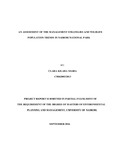| dc.description.abstract | There is a rising concern about the declining wildlife numbers in many protected areas in Africa. Nairobi National Park's unfenced southern area (Kitengela dispersal area) has over time undergone several modifications from an open, vast, communally possessed wet season grazing locale to heavily fragmented private property. The study aimed at analyzing selected large animal (Herbivore and Carnivore) trend numbers from 1970-2013, management techniques being employed by the park managers’ overtime and the park’s integrity.
Primary data was collected using questionnaires, key informant interviews and schedule observation. Secondary data sources were largely obtained from journal articles, published books, and other published and unpublished reports. Stratified random sampling and purposive sampling were used for sample selection. Both qualitative and quantitative data analysis methods were used. More specifically, descriptive statistics were used to summarise and interpret the findings. A multiple regression analysis was conducted to establish the relationship between the management techniques (Fencing, Maintenance of the Kitengela area, Translocation, Re-stocking, Prescribed burning) and the population numbers of wild animals
The study findings indicated that approximately 90% of the respondents indicated a change in the large animal population numbers and around 85% of the respondents claimed that the change was a decrease. Around 63% of the respondents mentioned that the management practices were conducted in accordance with the regulations in place, and the management techniques have not changed over time. The total animal trend for the 15 herbivore & carnivore species (Eland, Thomson’s gazelle, Giraffe, black backed jackal, leopard, cheetah) since 1970 to 2013 indicated some fluctuations with the 1990s experiencing the highest total counts of 42,802. In 1996 and 1997 the Lion population was at its peak with a mean of 8.44. Pearson’s chi square (χ2= 52.081, df= 9, p<0.05) was statistically significant, where the null hypothesis was rejected and the alternative hypothesis adopted.
To effectively conserve the park this study therefore recommends that wildlife conservation within and outside Nairobi national park should be guided by the implementation of the new Kitengela dispersal area land use policy by the Kajiado county government, which would enable the creation of a buffer zone outside the park. The success to a conserved park will require increased funding for research and monitoring purposes, community educational outreach programmes, purchasing of technological equipments and increasing capacity, in addition to enhanced communication and coordination among stakeholders. | en_US |



